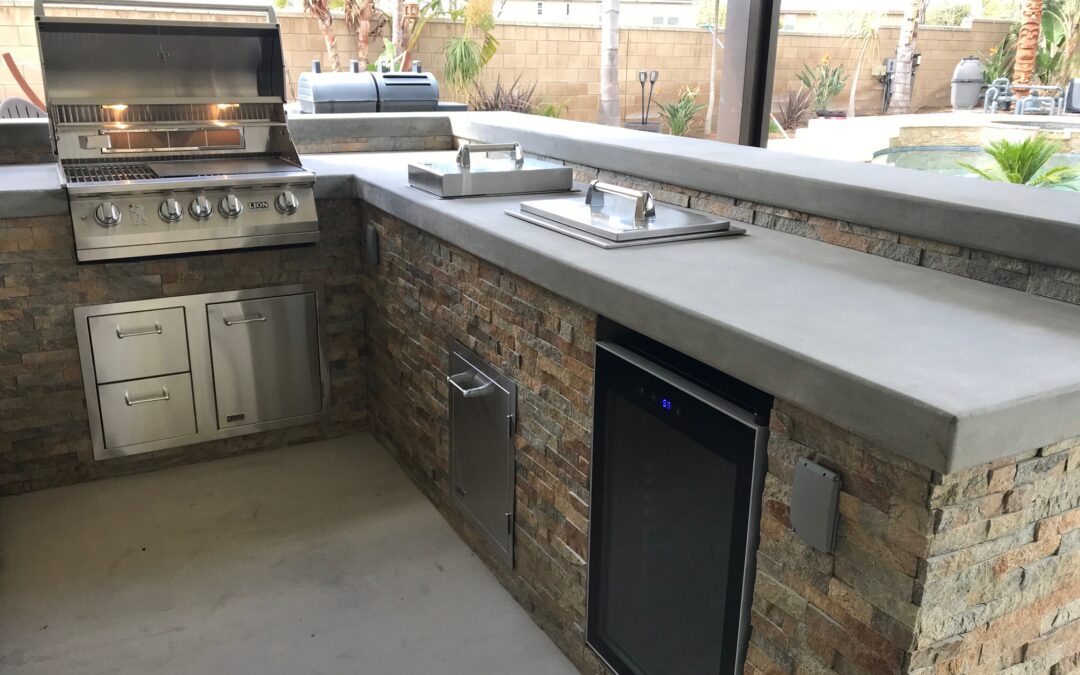Are todays BBQ Islands built to last? You might be surprised.
When I first started building BBQ islands, I quickly learned just how labor-intensive the process was. Back in the day, creating a simple 3×6 L-shaped BBQ island required a full pallet of 6x8x16 blocks—about 120 blocks—plus around four 90-pound bags of spec mix. It wasn’t just stacking blocks; we had to dig a footing, cut the blocks to size, and construct a sturdy frame. Then came the stucco finish and finally the concrete countertop. All told, it took a team of three skilled workers about two full weeks to complete just one BBQ island.
While clients loved the results, the pricing steadily increased over the years. Material prices have surged significantly since the early 2000s. Back then, a bag of concrete mix might have cost $5-$7; now, it’s easily $12-$15 or more. Steel prices have also climbed, driving up costs for everything from rebar to grill components. Labor costs haven’t lagged behind, either. It became clear to me that without innovation, BBQ islands would soon be luxury items reserved for only the wealthiest clients or die-hard culinary enthusiasts.
A Game-Changer: Lightweight BBQ Island Construction
Determined to find a better way, I began researching modern construction methods and met someone who worked for a BBQ island manufacturer. He introduced me to a revolutionary technique using steel studs and cement board (or Hardie backer). At first, I was skeptical. These materials were lightweight, and I doubted their strength, especially when considering the heavy-duty 3-inch concrete countertops my clients loved—countertops that can weigh upwards of 800 pounds for a 6-foot BBQ island.
But after building several islands using this method, I was amazed. Steel studs provide incredible structural strength, and cement board is both durable and resistant to weather, moisture, and heat. These islands held up beautifully under the weight of the countertops, proving that lightweight materials could deliver the same durability and longevity as traditional block construction.
Not only is this method faster and less labor-intensive, but it also keeps costs down, allowing me to offer high-quality outdoor kitchens to a broader range of clients.
Why Concrete Countertops are the Star of the Show
When it comes to BBQ islands, concrete countertops are a fan favorite—and for good reason. They’re not just functional but also highly customizable. Concrete offers endless design possibilities, with a wide range of colors, finishes, and textures to suit any outdoor space. From sleek, modern grays to warm earth tones or even custom-mixed colors, concrete countertops can elevate the aesthetic of any BBQ island.
Additionally, concrete is incredibly durable and heat-resistant, making it perfect for outdoor cooking spaces. Unlike tile countertops, which can crack or have grout that stains over time, concrete countertops are seamless, easy to clean, and built to withstand the elements.
What to Look Out For When Choosing a BBQ Island
If you’re in the market for a BBQ island, here are a few key considerations:
- Construction Materials: Ask about the frame construction. Steel stud and cement board are lightweight yet strong and weather-resistant.
- Countertop Material: Concrete is a superior choice for durability, customization, and style.
- Weight Capacity: Ensure the structure can handle heavy countertops and appliances.
- Customization Options: Look for builders who can tailor the design to your needs, whether it’s color-matching your countertops or fitting specific grills and appliances.

